This was published 7 years ago
Madagascar travel: The pinnacle of wildlife tourism
By Daniel Scott
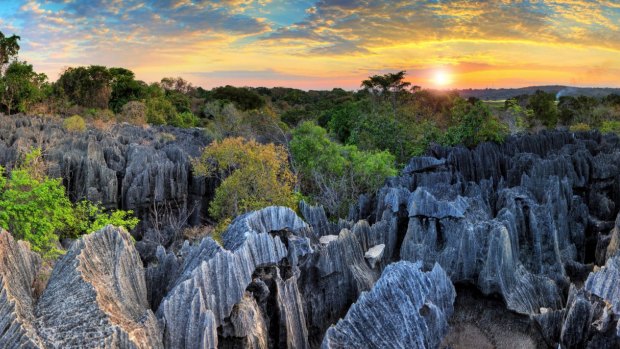
The unique geography of western Madagascar.Credit: iStock
From on high, it looks like a landscape conjured by the fantastical imagination of Tolkien or J.K. Rowling. All around the platform we're standing on, shards of limestone reach upwards like a forest of oversized, fragmented needles, protecting the approaches to a witch's castle.
Originally part of the seabed, the charcoal grey massif was pushed up 200-million years ago, then gouged, stripped and twisted by ground water, wind and rain into its present form.
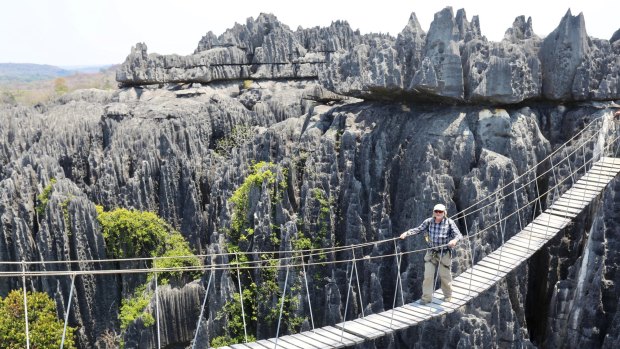
Rope ladder crossing in the TsingyCredit: Daniel Scott
Named the Tsingy (de Bemahara) in the Malagasy language, meaning "badlands" or "where one cannot walk barefoot", this Unesco World Heritage site is reason alone to visit remote Western Madagascar.
We reach it at the mid-way point of our 21-day Madagascar Adventure with World Expeditions, after some epic four-wheel-driving and four days canoeing down the Manonbolo River to the nearby tourist town of Bekopaka.
Accompanied by local guide T.S., we strike out for the jagged formation from our base at the riverside Croco camp, driving for an hour across country before beginning the three-kilometre loop trek through the Grand Tsingy, the larger of two outcrops.
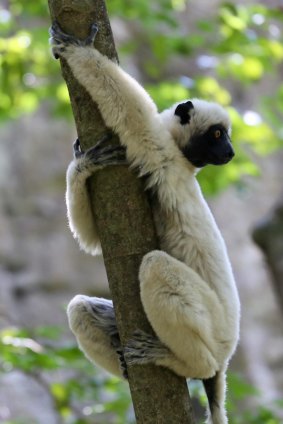
The white sifaka lemurs charm with big amber eyes, puppy-like noses and long, slender fingers and toes.Credit: Daniel Scott
If that sounds like a walk in the park, it isn't. After consulting locals, one of our group, 71-year-old Melburnian Peta, opts instead to visit the Petit Tsingy, via a more manageable trail.
For the others who brave it, 40-year-old Riant from England, who has had an major operation and ongoing treatment for a brain tumour, and his partner Julie, who nurses a fear of heights, the route into and up through the serrated karsts, is a serious challenge, especially on a hot, humid day.
Even fit pensioner Colin, a former Outdoor Education chief, emerges with a bloodied head from a close encounter with a cave roof.
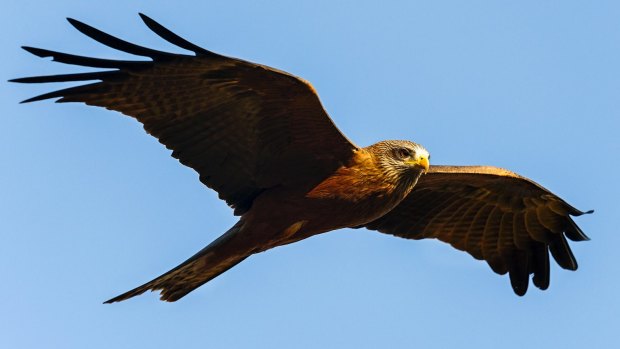
A black kite keeps watch.Credit: iStock
It takes us several hours to complete the modest distance around the Tsingy. This is partly because, due to its inaccessibility to man, this is one of the most biologically rich places in a country renowned for its biodiversity and high number of endemic creatures, and therefore cannot be hurried.
"For nature," T.S. tells us while we witness two groups of white sifaka lemurs fight for territory in the branches of the lower forest, "it is very very interesting here, like a landlocked island in an island."
The lemurs are the first of many animals we encounter on our approach to the pinnacles. Some, like the nocturnal brown sportif lemur sleeping in a tree hollow, T.S. knows where to find. Others, like the spiny-tailed lizards, mongoose and the rare jumping rat, appear suddenly beside us, as surprised by our presence as we are by theirs. Then there are those that only trained eyes can find – a light-brown chameleon perfectly camouflaged against a spindly tree trunk.
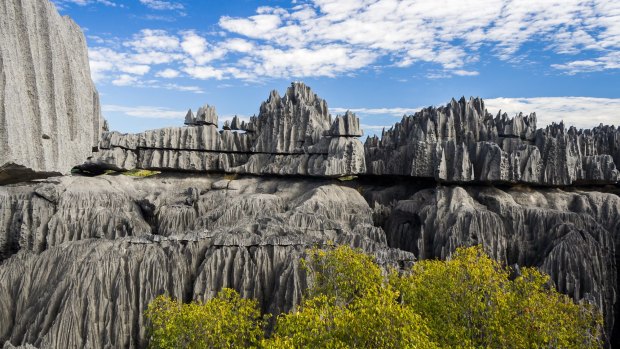
Tsingy de Bemaraha National Park.Credit: iStock
Nor is the circuit for the fainthearted, with ladders and small bridges over chasms to negotiate, some semi-canyoning required to squeeze between narrow gaps in the rock and shuffling and crawling necessary to get under low overhangs. Then, on the final stages of the ascent to the top, we don harnesses, to clip into safety cables bolted into the rock face, should anybody lose their footing.
Peering down on the razor-sharp blades of limestone, particularly from a flimsy-looking rope bridge strung across a yawning canyon, the idea of falling is unthinkable. Even the blase, me and fit Israeli, Baruch, take care here not to end up skewered on a Tsingy.
Yet, there is not one of us that would not willingly do it all again, for the journey to the top literally connects us to this otherworldly formation.
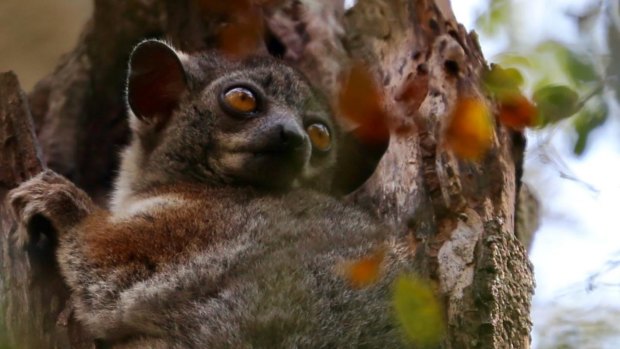
Nocturnal brown sifaka lemur.Credit: Daniel Scott
Although our descent is no less tricky, once we reach the forest floor again we are rewarded with an audience with another family of white sifaka lemurs. We watch from below as two babies, blithely unconcerned by our presence, are taken through their paces by their patient mums, learning how to swing, climb and hang upside down from the trees.
With their big amber eyes, puppy-like noses and long, slender almost-human fingers and toes and their eagerness to please their parents, they stop us in our tracks for more than 20 minutes.
TRIP NOTES
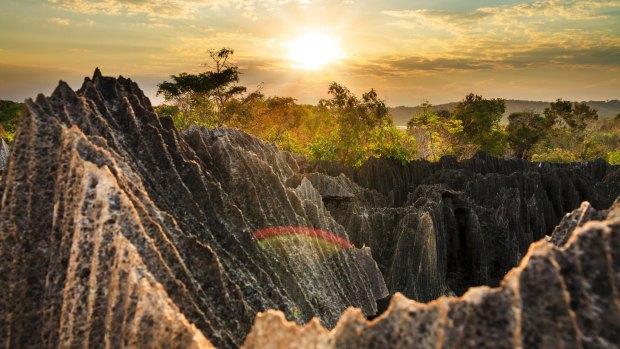
The sun sets in the Tsingy de Bemaraha.Credit: iStock
MORE INFORMATION
GETTING THERE
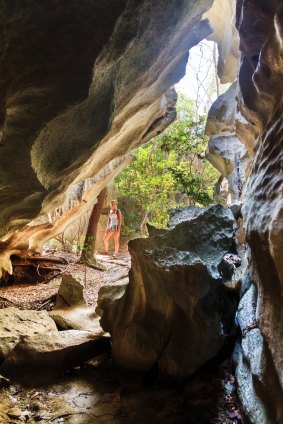
The unique limestone landscape at the Tsingy de Bemaraha.Credit: iStock
South African Airways has daily flights to Madagascar from Australia's East coast, via Perth and Johannesburg, connecting to the capital Antananarivo using SA Airlink. Flights from $2440 return, including taxes. Phone 1300 435 972, see flysaa.com.au
TOURING THERE
World Expeditions has a range of journeys exploring Madagascar. These include Madagascar Reef and Rainforests and Discover Madagascar with Dr Karl Kruszelnicki. Their 21-day Madagascar Adventure, from $4690 per person, visits Tsingy de Bemahara. Phone 1300 720 000, see worldexpeditions.com
Daniel Scott was a guest of World Expeditions, South African Airways and Airlink
Sign up for the Traveller Deals newsletter
Get exclusive travel deals delivered straight to your inbox. Sign up now.